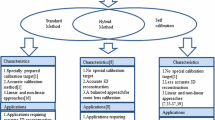Abstract
We propose new mathematical models to study the variation of lens distortion models when modifying zoom setting in the case of zoom lenses. The new models are based on a polynomial approximation to account for the variation of the radial distortion parameters through the range of zoom lens settings and, on the minimization of a global error energy measuring the distance between sequences of distorted aligned points and straight lines after lens distortion correction. To validate the performance of the method we present experimental results on calibration pattern images and on sport event scenarios using broadcast video cameras. We obtain, experimentally, that using just a second order polynomial approximation of lens distortion parameter zoom variation, the quality of lens distortion correction is as good as the one obtained individually frame by frame using independent lens distortion model for each frame.













Similar content being viewed by others
References
Devernay, F., Faugeras, O.: Straight lines have to be straight. Mach. Vis. Appl. 13(1), 14–24 (2001)
Faugeras, O., Luong, Q.-T., Papadopoulo, T.: The Geometry of Multiple Images. MIT Press, Cambridge (2001)
Tsai, R.Y.: A versatile camera calibration technique for high-accuracy 3D machine vision metrology using off-the-shelf tv cameras and lenses. IEEE J. Robot. Autom. 3(4), 323–344 (1987)
Faugeras, O.: Three-Dimensional Computer Vision. MIT Press, Cambridge (1993)
Weng, J., Cohen, P., Herniou, M.: Camera calibration with distortion models and accuracy evaluation. IEEE Trans. Pattern Anal. Mach. Intell. 14(10), 965–980 (1992)
Light, D.L.: The new camera calibration system at the US geological survey. Photogramm. Eng. Remote Sens. 58(2), 185–188 (1992)
Alvarez, L., Gomez, L., Sendra, R.: An algebraic approach to lens distortion by line rectification. J. Math. Imaging Vis. 35(1), 36–50 (2009)
Fraser, C.S., Shortis, M.R.: Variation of distortion within the photographic field. Photogramm. Eng. Remote Sens. 58(6), 851–855 (1992)
Fraser, C., Al-Ajlouni, S.: Zoom-dependent camera calibration in digital close-range photogrammetry. Photogramm. Eng. Remote Sens. 72(9), 1017–1026 (2006)
Bräuer-Burchardt, C., Heinze, M., Munkelt, C., Kühmstedt, P., Notni, G.: Distance dependent lens distortion variation in 3D measuring systems using fringe projection. In: BMVC 2006, pp. 327–336 (2006)
Irani, M., Anandan, P.: A unified approach to moving object detection in 2D and 3D scenes. IEEE Trans. Pattern Anal. Mach. Intell. 20(6), 577–589 (1998)
Hampapur, A., Brown, L., Connell, J., et al.: Smart video surveillance: exploring the concept of multiscale spatiotemporal tracking. IEEE Signal Process. Mag. 22(2), 38–51 (2005)
Martinez, E., Torras, C.: Contour-based 3D motion recovery while zooming. Robot. Auton. Syst. 44(3–4), 219–227 (2003)
Fahn, C., Lo, C.: A high-definition human face tracking system using the fusion of omni-directional and PTZ cameras mounted on a mobile robot. In: 5th IEEE Conference on Industrial Electronics and Applications (ICIEA), Taichung, China, pp. 6–11 (2010)
Fayman, J., Sudarsky, O., Rivlin, E.: Zoom tracking. In: Proceedings of the International Conference on Robotics and Automation, Leuven, Belgium, pp. 2783–2788 (1998)
Peddigari, V., Kehtarnavaz, N.: A relational approach to zoom tracking for digital still cameras. IEEE Trans. Consum. Electron. 51(4), 1051–1059 (2005)
Ergum, B.: Photogrammetric observing the variation of intrinsic parameters for zoom lenses. Sci. Res. Essays 5(5), 461–467 (2010)
Wilson, R., Shafer, S.: A perspective projection camera model for zoom lenses. In: Proc. Second Conference on Optical 3-D Measurements Techniques, Switzerland, October (1993)
Tarabanis, K., Tsai, R., Goodman, D.: Modeling of a computer-controlled zoom lens. In: Proceedings of IEEE International Conference on Robotics and Automation, vol. 2, pp. 1545–1551 (1992)
Li, M., Lavest, J.: Some aspects of zoom lens camera calibration. IEEE Trans. Pattern Anal. Mach. Intell. 18(11), 1105–1110 (1996)
Atienza, R., Zelinsky, A.: A practical zoom camera calibration technique: an application on active vision for human-robot interaction. In: Proceedings of Australian Conference on Robotics and Automation, Sydney, Australia, pp. 85–90 (2001)
Benhimane, S., Malis, E.: Self-calibration of the distortion of a zooming camera by matching points at different resolutions. In: Proceedings of IEEE/RSJ International Conference on Intelligent Robots and Systems, Sendai, Japan, pp. 2307–2312 (2004)
Kim, D., Shin, H., Oh, J., Sohn, K.: Automatic radial distortion correction in zoom lens video camera. J. Electron. Imaging 19(4), 43010–43017 (2010)
Alvarez, L., Esclarín, J., Trujillo, A.: A model based edge location with subpixel precision. In: Proceedings IWCVIA 03: International WorkShop on Computer Vision and Image Analysis, Las Palmas de Gran Canaria, Spain, pp. 29–32 (2003)
Alemán-Flores, M., Alvarez, L., Henríquez, P., Mazorra, L.: Morphological thick line center detection. In: Proceedings ICIAR’2010. LNCS, vol. 6111, pp. 71–80. Springer, Berlin (2010)
Zhang, Z.: A flexible new technique for camera calibration. IEEE Trans. Pattern Anal. Mach. Intell. 22(11), 1330–1334 (2000)
Acknowledgements
This research has partially been supported by the MICINN project reference MTM2010-17615 (Ministerio de Ciencia e Innovación. Spain). We acknowledge MEDIAPRODUCCION S.L. company who has kindly provided to us with the real soccer video sequence we use in the numerical experiments.
Author information
Authors and Affiliations
Corresponding author
Rights and permissions
About this article
Cite this article
Alvarez, L., Gómez, L. & Henríquez, P. Zoom Dependent Lens Distortion Mathematical Models. J Math Imaging Vis 44, 480–490 (2012). https://doi.org/10.1007/s10851-012-0339-x
Published:
Issue Date:
DOI: https://doi.org/10.1007/s10851-012-0339-x




